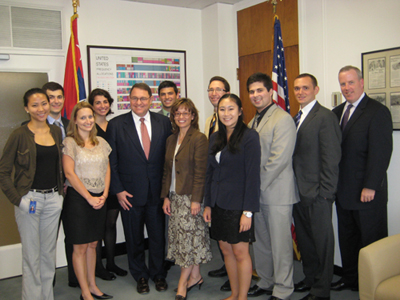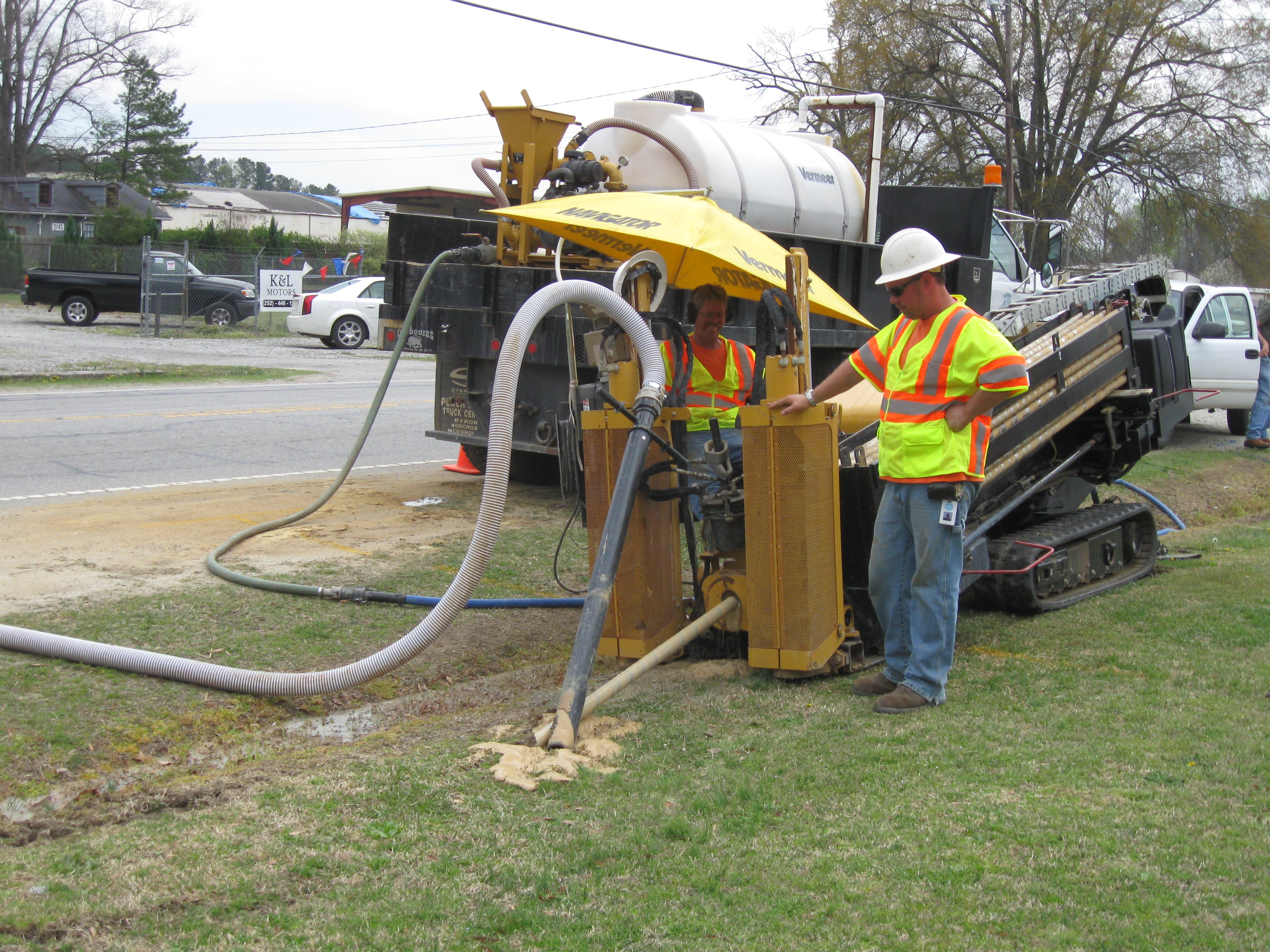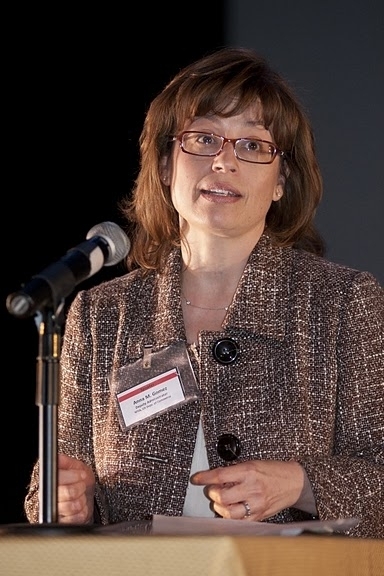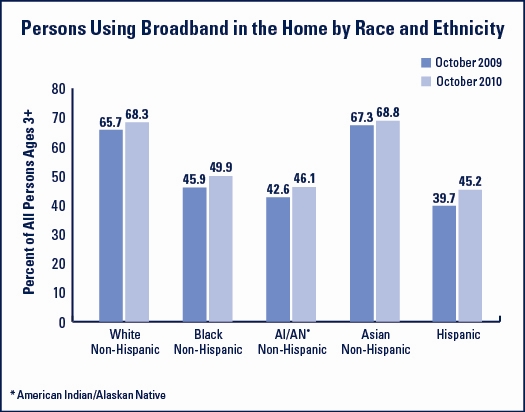NTIA Blog
Digital Literacy is Part of Job Preparedness
Broadband Internet is a catalyst for job creation. In fact, a recent report by McKinsey & Company finds that the Internet has created 2.6 jobs for each job it has eliminated. To take full advantage of the economic opportunities enabled by broadband, however, more Americans need online skills. For instance, broadband service allows a small business owner in rural America to sell her goods to consumers around the world – but online skills are also required.
NTIA’s research shows that nearly one-third of Americans (28.3 percent) do not use the Internet, leaving them cut off from the online economy. Many are rural Americans, seniors, minorities, people with disabilities, the unemployed, and those with low incomes. The most common reason for not adopting broadband is the perception that it is not needed. But broadband is increasingly needed to find jobs, and 21st century skills are needed to get those jobs.
NTIA is working on several fronts to help bridge this digital divide. Most notably, our Broadband Technology Opportunities Program (BTOP) has invested in approximately 230 projects to expand broadband access and adoption in communities nationwide. Funded by the Recovery Act, BTOP projects have already delivered more than 8,000 miles of broadband networks and installed or upgraded more than 9,000 workstations at public computer centers.
NTIA Wraps Up Summer Session of its Internship Program
The summer heat relents, and NTIA celebrates the success of its internship program!
As one of NTIA's nine summer interns, I spent the past two months working in NTIA's Office of Public Affairs helping to manage a range of activities related to the agency's web presence and media relations. Much of my work focused on helping to develop NTIA's new website, track news coverage, and highlight some of the Broadband Technology Opportunities Program (BTOP) grantees' ongoing progress and success stories.

NTIA, under the leadership of Assistant Secretary Strickling, is building a strong internship program with year-round opportunities for students to help support the agency's work as the President's principle advisor on telecommunications and information policy issues. Pictured from left to right: Susan Tan, Kacper Szczepaniak, Agatha Cole, Margaret Ross-Martin, Assistant Secretary Lawrence E. Strickling, Ryan Hatoum, Deputy Assistant Secretary Anna M. Gomez, Rafi Goldberg, Jaclyn Ong, Alexander Ratner, Tom Randall, Deputy Chief of Staff and Internship Coordinator Jim Wasilewski
New Promise for Rural North Carolina
Last Friday, I visited Kannapolis, North Carolina to attend a groundbreaking ceremony for the second phase of an infrastructure project that will deploy or improve broadband networks throughout much of the state, particularly in rural areas. The effort is led by MCNC, a nonprofit broadband provider that has operated the North Carolina Research and Education Network (NCREN) for more than 25 years. The project—funded by a $104 million Recovery Act investment and $40 million in private sector matching funds—will deploy approximately 1,650 miles of new fiber. Combined with upgraded facilities, the project will add 2,600 miles of new or improved infrastructure to MCNC’s network, extending broadband to nearly 1,200 community anchor institutions, including universities, schools, community colleges, libraries, healthcare providers, and public safety facilities. Nearly 500 of those anchor institutions have already benefitted from improved access to the broadband network. Joe Freddoso, the president and CEO of MCNC, said they applied for the Recovery Act funding because bandwidth use by North Carolina institutions was growing by 30 to 40 percent each year—and without network improvements, rural communities would not be able to meet their future bandwidth needs.
Public Computer Centers Helping Los Angeles Job Seekers
Last week I visited a new WorkSource Center Satellite in South Los Angeles, where a Recovery Act investment by NTIA has funded 25 new computer stations that community members seeking jobs can use. Coupled with hands-on assistance and career counseling from trained personnel, this investment is creating economic opportunities in a neighborhood where poverty and unemployment rates are unacceptably high. All told, NTIA’s $7.5 million grant to the City of Los Angeles for its Computer Access Network (LA CAN) project – part of a $4 billion Recovery Act investment to expand broadband access and adoption in communities nationwide – will upgrade more than 180 public computer centers in some of the city’s neediest neighborhoods.
The WorkSource Center Satellite is located with the Chicana Service Action Center, whose CEO, Sophia Esparza, told me how the project is preparing job-seekers, not for yesterday’s jobs, but for the “green jobs” of the future. Customers, including returning veterans and Temporary Assistance for Needy Families (TANF) recipients, are benefiting from strong partnerships between the city and local employers to place solar installers, energy auditors, lead green technicians and electrical auto technicians into well-paying jobs.
Broadband Investment in Massachusetts Paving Way for Jobs of the Future
This week construction began on a fiber-optic network that will bring broadband Internet service to more than 120 communities in western and north central Massachusetts. Thanks in large part to a $45.4 million Recovery Act investment from NTIA, the project will help residents and businesses in these underserved parts of the state to better compete in today’s knowledge-based economy.
On Tuesday, I joined state and local officials, members of the project team at the Massachusetts Broadband Institute (a state-created organization that is our grantee), businesses, and others in the community to discuss the initiative, called MassBroadband 123. It will deploy broadband service to nearly 1,400 community anchor institutions, including schools, community colleges, libraries, healthcare providers, and public safety facilities – like the Sandisfield Fire Station where we met, and whose fire chief has emphasized the importance of up-to-date technology for keeping residents safe.
Report from the Field: Deploying Broadband Infrastructure in North Carolina
As part of BTOP’s comprehensive oversight of its grant recipients, I recently spent several days in North Carolina conducting an on-site review of two broadband infrastructure projects.
Local broadband provider MCNC received two BTOP grants that together will fund deployment of more than 2,000 miles of new fiber infrastructure. The new infrastructure will reach 69 counties and directly connect more than 500 community anchor institutions across the state, including universities, hospitals, and public safety facilities. To date, MCNC has deployed more than 140 miles of conduit, with plans to begin running fiber-optic cable through the conduit in the coming weeks.
During my visit, I examined MCNC’s project management approach, project status, grants management procedures, financial practices and controls, and compliance with BTOP and Recovery Act program requirements. My review included a productive series of meetings with MCNC that after two days of rolling up our sleeves yielded a better understanding of our shared objectives and the challenges associated with deploying and managing statewide projects.

Investing in Maryland's Technology Future
This month I had the honor of hosting our Federal, State and local partners as we formally kicked off the construction phase of the One Maryland: Inter-County Broadband Network (ICBN) Recovery Act funded-project. This project is important to me because it will allow the State of Maryland to bring sorely needed broadband resources to every corner of the State and foster cooperation across many layers of government.
Broadband and the Latino Community: Let's Keep the Momentum Going!
Yesterday I was happy to participate in a panel discussion about broadband at the National Association of Latino Elected and Appointed Officials (NALEO) annual conference in San Antonio. NALEO members recognize that broadband Internet is one of the tools necessary to help their communities thrive in today's economy. In fact, I think that any conference focused on building stronger communities should include a discussion of broadband - it's a critical ingredient for job creation, economic growth, and improving education, health care, and public safety.
I talked about challenges and opportunities. NTIA's data show that although 90-95 percent of Americans live in areas with access to broadband, only 68 percent of households subscribe to the service. In fact, more than 28 percent of Americans do not use the Internet in any location, which means they are cut off from countless educational and job opportunities.
The issue is even greater for Latinos. While the Internet subscribership rate for Hispanics increased by five percentage points last year, it is still only 45 percent. Even after adjusting for socioeconomic factors like income and education, Latinos still significantly lag the national rate in broadband adoption.
D.C. Adult Learners Prepare for Success in the Digital Economy
Earlier this month, I saw firsthand the benefits of our sustainable broadband adoption projects when I attended a graduation ceremony in D.C. Byte Back, a BTOP grantee partner, held a ceremony for adults who completed computer and jobs-skills training courses. At the graduation I met students who showed me how these courses are enabling them to cross the digital divide and open doors to new opportunities.
One of the graduating students was a mother who had to seek out her teenage daughter’s help in order to pass the course. Another graduate was a senior who came to the program when her computer broke. She enjoyed the courses so much that she is now a volunteer with the program, helping to teach other seniors valuable computer skills that can help them stay informed and connected. Several others were already finding ways to put their new skills to work and had lined up job opportunities.

Digital Literacy Initiative Aims to Help Americans Build Online Skills
Today, Commerce Secretary Gary Locke launched DigitalLiteracy.gov, a new online portal to help Americans find jobs and obtain the 21st century skills being sought by today’s employers.
The Commerce Department’s National Telecommunications and Information Administration (NTIA) developed DigitalLiteracy.gov in partnership with nine Federal agencies, with the goal of creating an online hub for librarians, educators, and other digital literacy practitioners to share content and best practices. Through DigitalLiteracy.gov, NTIA is making available to all Americans the methods for improving broadband adoption that are being developed by Recovery Act projects.
Resources and tools on the site can be used to teach and help develop digital literacy skills including lesson plans, online training tools, and train-the-trainer materials. In addition, any user can go to the site’s workforce page to connect to a wide variety of career-building applications that teach a range of skills including word processing fundamentals, resume -building tips, and job search techniques.
The premise is simple: We live in an Internet economy where high-speed Internet access and online skills are necessary for seeking, applying for, and getting today’s jobs. DigitalLiteracy.gov will help Americans build the online skills needed to fully share in the benefits of broadband, including developing workforce skills, finding reliable healthcare information, or designing a website.

